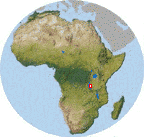 Mahale Mountains National Park, Tanzania
Mahale Mountains National Park, Tanzania Mahale Mountains National Park, Tanzania
Mahale Mountains National Park, TanzaniaThe information on this page was compiled specifically for this site. Kyoto University has its own web site for Mahale Mountains. It is one of the only field sites with a web page, and is included here for your reference.
The following chronology is summarised from Nishida, T. (1990). Kyoto University has also compiled its own chronology at: Chronology of Research at Mahale to 1995.
Primary source for the following Site Data is McGrew et. al. (1996), Great Ape Societies (Cambridge University Press), Appendix.
| Name: | Mahale Mountains Wildlife Research Centre |
| Location: | Tanzania, Kigoma Region, 6° 07' S 29° 44' E |
| Status: | National Park |
| Area: | 1613km2 |
| Altitude: | 773-2515m |
| Temp: |
18.3°C and 29°C - Kansyana 20.7°C and 30.2°C - Myako 19.5°C and 29.7°C - Bilenge |
| Rainfall: |
1836mm (1975-1988) 1835.5mm (1973-88) Kansyana Camp 1774.0mm (1976-84) Myako Camp 1419.0mm (1978-82) Bilenge |
|
Vegetation Vegetation 1(41K) Vegetation 2 (36K): |
Tropical semi-evergreen forest, miombo woodland. (1) Based on Nishida & Uehara, 1981 & 1983. (2) Based on Wrangham, nd. |
|
Human influence: |
Provisioning 1966-87 Disturbance ratings -- 1, 2, 1, 2, 1 |
|
Closest village: | 20km |
|
Species studied: | P. t. schweinfurthii |
|
Population Density (6K): |
0.35 - 0.45 individuals per km2 for whole park 5.4 - 5.8 per km2 for K & M groups (See link for other figures) |
| Fauna (14K): | Click here for fauna list, mostly mammals, other contributions welcome! |
|
Study period: | 1965-present |
| Habituation: | Excellent |
|
Research presence: | Permanent |
| Conservation: | Ecotourism |
|
Current research: | Social relationships, hunting, feeding ecology, tool-using, zoopharmacognosy, vocal communication |
| Methods: | Focal-subject sampling |
|
Contact person: | Toshisada Nishida, Dept of Zoology, Faculty of Science, Kyoto University, Kyoto, Japan 606 |
| Habitat photos | A selection of photos illustrating habitat and location. |
| Maps | Topographic maps. |
| Aerial photos | Vertical and oblique aerial photos. |
| Bibliography 1: | Link to Mahale Home Page's list of English publications to 1995 (by Kyoto University) |
| Bibliography 2: | Compiled for this site |
| Miscellaneous | Related links |